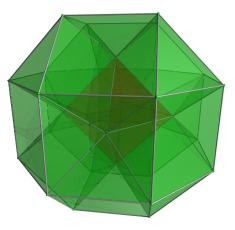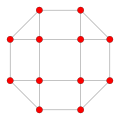This article relies largely or entirely on a single source .(April 2024) |
| Octahedral cupola | ||
|---|---|---|
 Schlegel diagram | ||
| Type | Polyhedral cupola | |
| Schläfli symbol | {3,4} v rr{3,4} | |
| Cells | 28 | 1 {3,4} 1 rr{4,3} 8+12 {}×{3} 6 {}v{4} |
| Faces | 82 | 40 triangles 42 squares |
| Edges | 84 | |
| Vertices | 30 | |
| Dual | ||
| Symmetry group | [4,3,1], order 48 | |
| Properties | convex, regular-faced | |
In 4-dimensional geometry, the octahedral cupola is a 4-polytope bounded by one octahedron and a parallel rhombicuboctahedron, connected by 20 triangular prisms, and 6 square pyramids. [1]





